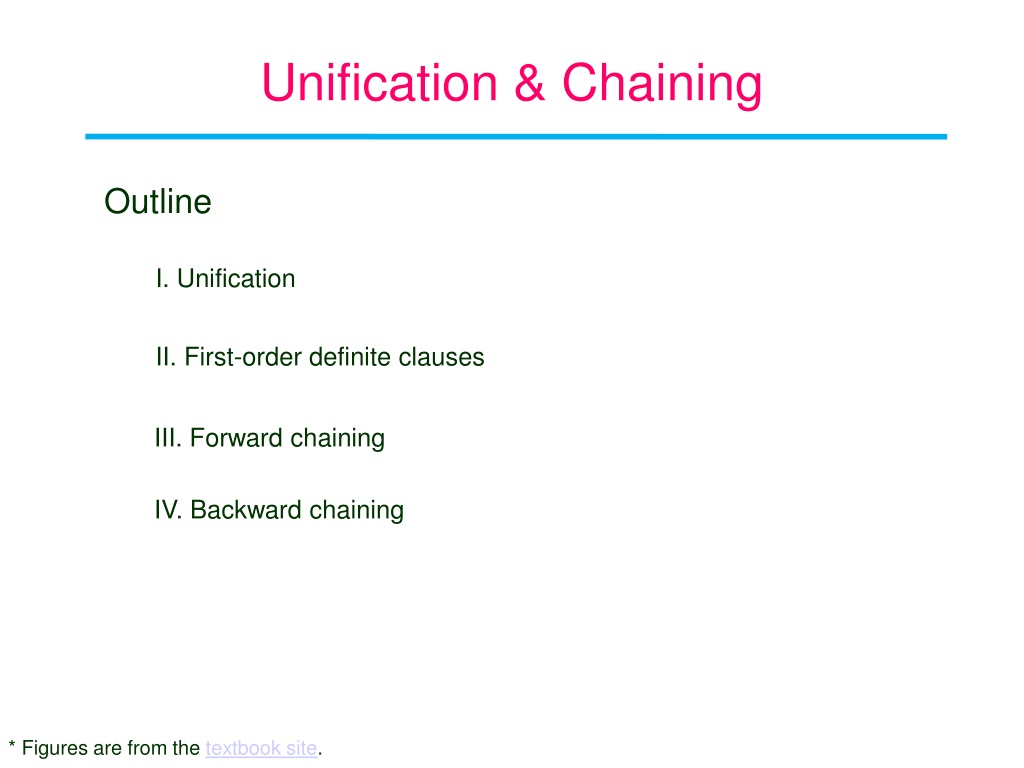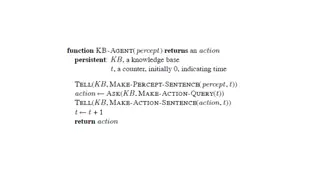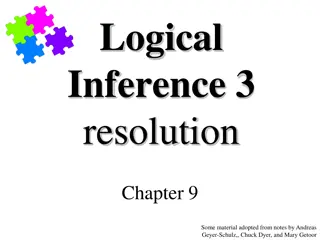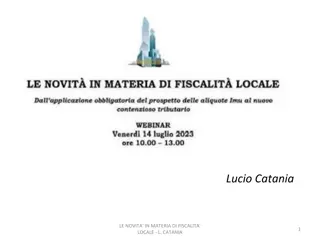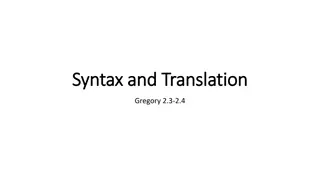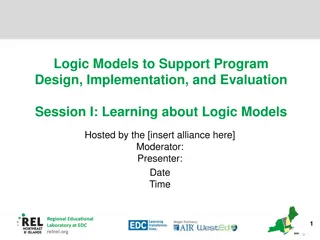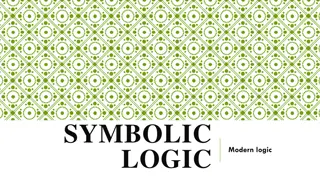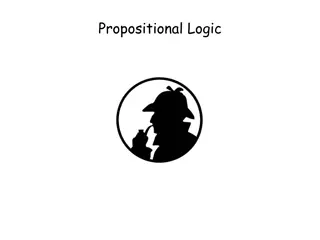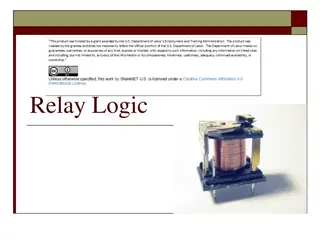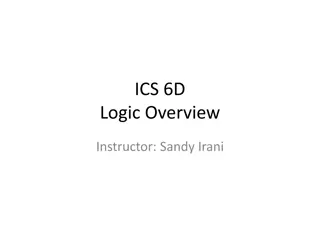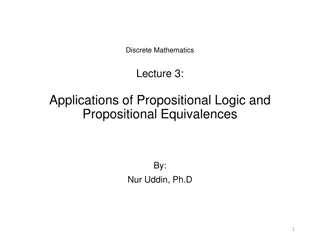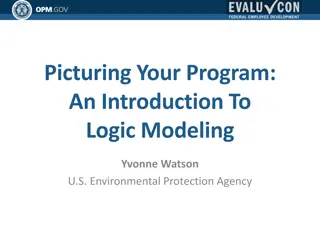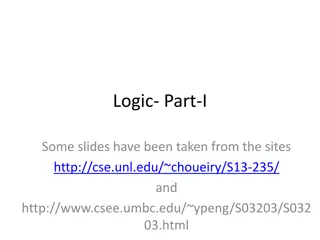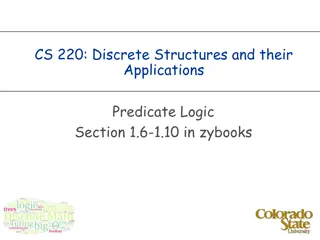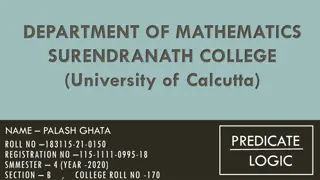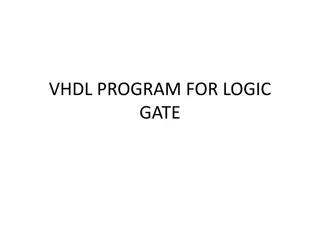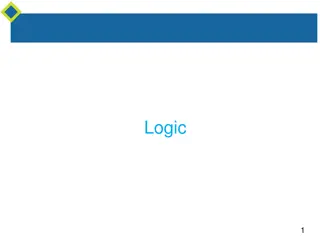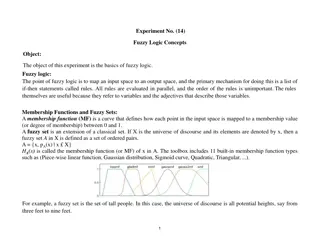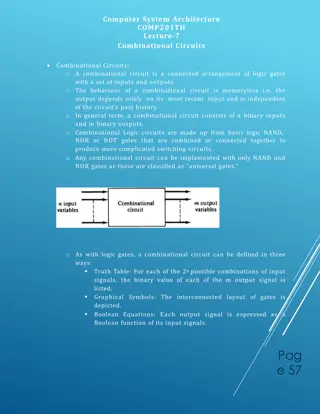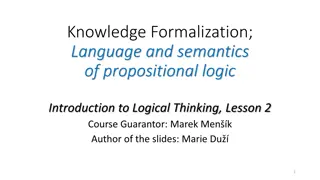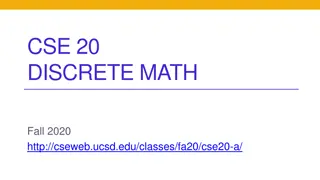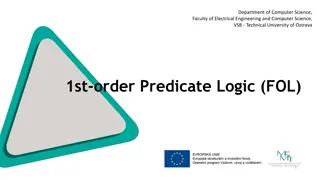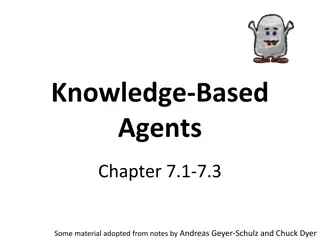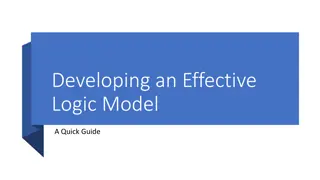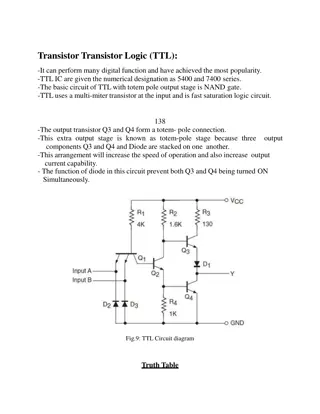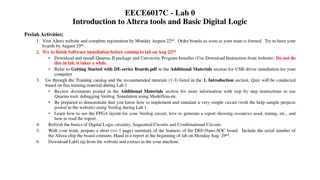Understanding Unification and Chaining in Logic
Unification and chaining are essential concepts in logic, allowing for the identification of substitutions to make logical expressions identical. The process involves finding unifiers through algorithms like UNIFY, managing conflicting substitutions, and exploring expressions to build unifiers. Multiple unifiers, less general unifiers, and function symbols play crucial roles in this process.
Download Presentation

Please find below an Image/Link to download the presentation.
The content on the website is provided AS IS for your information and personal use only. It may not be sold, licensed, or shared on other websites without obtaining consent from the author. Download presentation by click this link. If you encounter any issues during the download, it is possible that the publisher has removed the file from their server.
E N D
Presentation Transcript
Unification & Chaining Outline I. Unification II. First-order definite clauses III. Forward chaining IV. Backward chaining * Figures are from the textbook site.
I. Generalized Modus Ponens ?1 ?2 ?? ? , ?1 ,?2 , ,?? Suppose there exists a substitution ? such that for 1 ? ? SUBST ?,?? = SUBST ?,?? Example ? = 1, ?1 Dad ?,John , ?1 Dad David,? , ? = ?/David, y/John Then ?1 ?2 ?? ? ,?2 , ,?? , ?1 SUBST ?,? KB: Gate ?1, Terminal In(1,?1) Gate(?) Terminal(?) ? ? ? = {?/?1,?/ In(1,?1) } ? is ? ? SUBST ?,? ?1 In(1,?1)
Unification The process of finding substitutions that make different logical expressions look identical. Carried out by the algorithm UNIFY. UNIFY ?,? = ?where SUBST ?,? =SUBST(?,?) sentences Query: Answers: all the sentences in the KB found to unify with Knows John,? . // what does John know? AskVars(Knows John,? ) UNIFY(Knows(John, ?), Knows(John, Jane)) ={?/Jane} UNIFY(Knows(John, ?), Knows(?, Bill)) ={?/Bill,?/John} UNIFY(Knows(John, ?), Knows(?, Mother(?))) ={?/John, ?/Mother(John)}
Unification (contd) Conflicting substitutions UNIFY(Knows(John, ?), Knows(?, Elizabeth)) = failure ? cannot take on the values John and Elizabeth at the same time! {?/John} {?/Elizabeth} Multiple unifiers UNIFY(Knows(John, ?), Knows(?, ?)) could return {?/John, ?/?} or {?/John, ?/John, ?/John} less general unifier Knows(John, ?) more general unifier for fewer restriction on variable values Knows(John, John)
Unification Algorithm function symbol of ? argument list of ? // check whether the variable var appears // inside the complex term ?. match fails if so // because no unifier can be constructed. Recursively explore two expressions ? and ? side by side to build up a unifier.
Unification Example Variables: ?,?,? UNIFY ? ?,? ?,? ,? ,? ?,?,? ?,? ,{} ?,?,{} ?,? ?,? ,? , ?,?,? ?,? , ?/? {?/?, ?/?(?,?)} ?,?,{} ? ?,? ,? , ?,? ?,? , ?,? ?,? , {?/?, ?/?(?,?)} ?/? ? ?,? ,?, ?/? ?(?,?),? ?,? , {?/?, ?/?(?,?)} {?/?, ?/?(?,?)} ?,?, {?/?, ?/?(?,?)} ?,? , ?,? , {?/?, ?/?(?,?)} {?/?,?/?, ?/?(?,?)} ?,?, {?/?, ?/?(?,?)} ?,?, {?/?, ?/?(?,?)} {?/?,?/?, ?/?(?,?)}
II. First-Order Definite Clauses A first-order definite clause is a disjunction of literals of which exactly one is positive. single positive literal (i.e., fact in propositional logic if no variable) Bird(Ostrich) an implication whose premise is a conjunction of positive literals and whose conclusion is a single positive literal (i.e., definite clause in PL) Human(Socrates) Fallible(Socrates) variables allowed and implicitly under universal quantification // interpreted as ? Human(?) Fallible(?) Human(?) Fallible(?) // interpreted as ?,? Gate(?) Terminal(?) ? ? Gate(?) Terminal(?) ? ? existential quantifiers not allowed
Translation of Sentences The law says that it is a crime for an American to sell weapons to hostile nations. The country Nono, an enemy of America, has some missiles, and all of its missiles were sold to it by Colonel West, who is American. it is a crime for an American to sell weapons to hostile nations : // ? American(?) Weapon(?) Hostile(?) Sells(?,?,?) Criminal(?) Nono has some missles : // ? Owns(Nono,?) Missile(?) Owns(Nono,?1) Missile(?1) introducing a Skolem constant to eliminate All of its missiles were sold by Colonel West : // ? Missile(?) Owns(Nono,?) Sells(West,?,Nono)
Completing the KB Need to know that missiles are weapons. Missile(?) Weapon(?) Also need to know that an enemy of America counts as hostile . Enemy(?,America) Hostile(?) West, who is American American(West) The country Nono, an enemy of America Enemy(Nono,America) The KB consists of first-order definite clauses with no function symbols. It is called a Datalog.
III. Simple Forward Chaining 1. Start from the known facts. 2. Trigger all the rules whose premises are satisfied. 3. Add their conclusions to the known facts. 4. Repeat steps 2 and 3 until one of the following situations occurs: a. The query is answered. b. No new facts are added. A new fact is not a renaming of a known fact. Likes(?,IceCream) is a renaming of Likes(?,IceCream). Both have the meaning: Everyone likes ice cream .
Execution of Forward Chaining KB: American(?) Weapon(?) Hostile(?) Sells(?,?,?) Criminal(?) Owns(Nono,?1) Missile(?1) Missile(?) Owns(Nono,?) Sells(West,?,Nono) Missile(?) Weapon(?) Enemy(?,America) Hostile(?) American(West) Enemy(Nono,America) Iteration 1 adds: Iteration 2 adds: Criminal(West) Sell?(West,?1,Nono) Weapon(?1) KB has now reached a fixed point, meaning that no new sentences are possible. Hostile(Nono)
Proof Tree Soundness of forward chaining Every inference is an application of Generalized Modus Ponens. Completeness Easy to establish if no function symbols appears in the KB. Guaranteed except for a query with no answer, the algorithm could fail to terminate. E.g., NatNum(0) and NatNum(?) NatNum(?(?)).
Improvement 1: Matching Rules Against Known Facts Inefficiency of simple forward chaining: Exhaustively matches every rule against every fact. Rechecks every rule on each iteration (even with very few additions to KB). Generates many facts that are irrelevant to the goal. Missile(?) Owns(Nono,?) Sells(West,?,Nono) Suppose Nono owns many objects among which very few are missiles. They are two approaches: Find all the objects owned by Nono and, for each, check if it is a missile. Find all the missiles first and check if they are owned by Nono. More efficient! How to order the conjuncts of the rule premise so they can be solved with the minimum total cost? Use a heuristic, e.g., the minimum-remaining- values (MRV) heuristic for CSPs. NP-hard!
CSP as a Definite Clause View every conjunct in the premise as a constraint on the variables it contains. color of WA (a Skolem constant) Diff(wa,nt) Diff(wa,sa) Diff(nt,q) Diff(nt,sa) Diff(q,nsw) Diff(q,sa) Diff(nsw,v) Diff(nsw,sa) Diff(v,sa) Colorable() Diff(Red,Blue) Diff(Green,Red) Diff(Blue,Red) Diff(Red,Green) Diff(Green,Blue) Diff(Blue,Green) Graph coloring Constraint satisfaction is NP-hard. Matching a definite clause against a set of facts (under unification) is NP-hard. Good news View every Datalog clause as a CSP and apply heuristics for CSPs (e.g., tree structure, cutset conditioning, etc.).
Improvement 2: Incremental FC Observations Every new fact inferred on iteration ? must be derived from at least one new fact inferred on iteration ? 1. Only a small fraction of the rules are triggered by a fact. Incremental forward chaining does the following during iteration ?: 1. Check a rule only if its premise includes a conjunct ?? that unifies with a fact ?? inferred at iteration ? 1. . 2. Extends the substitution to match ?? with ?? 3. Repeat for every such conjunct in the premise of the same rule. 4. The remaining conjunts are matched with facts from iterations at or before ? 1. E.g., the Rete algorithm
IV. Backward Chaining Works like AND/OR search: OR The goal query can be proved by any rule in the KB. A query containing a variable, e.g., Person(?) can be proved in multiple ways. AND: all the conjuncts in the premise of a clause must be proved. How does it work? Fetch all clauses that unify with the goal. Rename the variables in every such clause to be brand-new. Prove every conjunct in the clause by keeping track of the expanded substitution as it goes.
Depth-First Proof Tree American(?) Weapon(?) Sells(?,?,?) Hostile(?) Criminal(?) Missile(?) Owns(Nono,?) Sells(West,?,Nono) Missile(?) Weapon(?) Enemy(?,America) Hostile(?) Owns(Nono,?1) Missile(?1) American(West) Enemy(Nono,America) {?/West} Atomic fact is considered as a clause whose left- hand side is an empty list.
